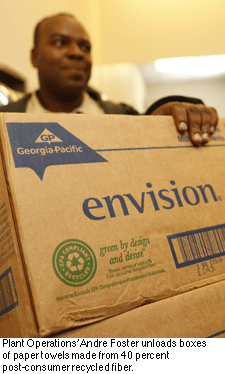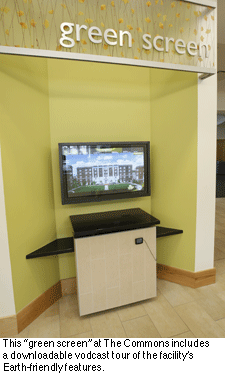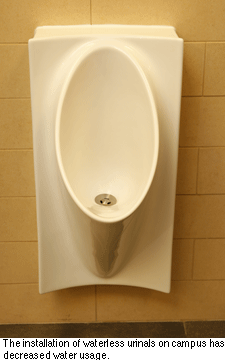Black + Gold = Green
[Originally published by Vanderbilt News Service in The Vanderbilt View]
When it comes to sustainability, Vanderbilt is rewriting the equation.
By David Green
Photography by Steve Green and John Russell

When Andrea George took the helm of the newly created Sustainability and Environmental Management Office, she had no idea she’d spend so much time talking about, well, waterless urinals.
Despite Vanderbilt’s much-lauded green building efforts – most notably being the first in the state to earn certification by the U.S. Green Building Council’s Leadership in Energy and Environmental Design (LEED) for construction on The Commons – what most people are interested in are the newly installed, standard-defying flushers.
“One of the questions I get asked the most is how the waterless urinals work,” George said. “It is actually pretty interesting, since they utilize a really smart application of simple chemistry and physics.”
For the record, a chemical in the trap of the urinal makes the urine sink, while the chemical floats to the top, sealing in odor, she said. A traditional urinal uses about 40,000 gallons of water per year. Thanks to these high-tech contraptions – 42 of which were installed on campus in 2007, in addition to 109 low-flow faucets and 121 low-flow toilets – Vanderbilt’s water usage has decreased by about 4.94 million gallons per year.
Urinals and toilets, thankfully, aren’t the only concern of George, who currently coordinates a multitude of other sustainability efforts that are quietly transforming campus – one recycling bin, compost pile and energy-efficient light bulb at a time.
As Middle Tennessee’s largest private employer, with 22,000-plus employees and thousands more visitors occupying the 330-acre campus each day, reducing energy usage is not a new idea at Vanderbilt. To wit, 35 percent of the electricity consumed by the university is generated by an on-campus powerhouse, which reduces the losses incurred by long-distance transmission, according to Mark Petty, assistant vice chancellor for Plant Operations.
“We get a lot of comments about burning coal at the power plant,” Petty said, “but in fact, Vanderbilt is saving large amounts of electricity by running its own operation rather than buying power from the Tennessee Valley Authority.”
What’s more, each lump of coal is used more efficiently, because it produces electricity as well as steam used for everything from heating buildings to cooking food. Overall, Vanderbilt’s homegrown plant saves about 45 percent on electricity, Petty said.
 A variety of alternatives to electricity have been suggested and considered over the years, including the use of wind turbines and solar panels. But, as George pointed out, they don’t make sense for Vanderbilt – at least not yet.
A variety of alternatives to electricity have been suggested and considered over the years, including the use of wind turbines and solar panels. But, as George pointed out, they don’t make sense for Vanderbilt – at least not yet.
“The inconsistent sunshine we get here won’t generate enough electricity to offset the substantial cost of installing large arrays of solar panels,” she said. “Nor is it windy enough to justify building turbines. Nashville is, unfortunately, at the sad vortex where we don’t have favorable conditions for solar energy or wind energy or even biomass energy, according to the National Renewable Energy Laboratory.
“However, we will continue to evaluate the potential for application of these alternative energy production methods here at Vanderbilt as the technologies advance.”
Knowing what does make sense for Vanderbilt is a core mission for the folks in George’s office. As the university works to make the environment healthier, it also must stay financially and socially healthy. All parts of this “triple bottom line” have to fall into place for a sustainability project to work. For example, it may make sense environmentally and financially to dim outdoor campus lighting at night, but the impact on safety means that the social bottom line isn’t quite there.
 Certain ideas are no-brainers: turning off lights, recycling paper and turning down the thermostat, to name a few. But there are many aspects of Vanderbilt’s impact on the environment that have yet to be explored. That’s why George is not willing to predict where Vanderbilt’s sustainability program will be five or 10 years from now. With the official sustainability effort only two years old, there’s a lot Vanderbilt still doesn’t know about itself.
Certain ideas are no-brainers: turning off lights, recycling paper and turning down the thermostat, to name a few. But there are many aspects of Vanderbilt’s impact on the environment that have yet to be explored. That’s why George is not willing to predict where Vanderbilt’s sustainability program will be five or 10 years from now. With the official sustainability effort only two years old, there’s a lot Vanderbilt still doesn’t know about itself.
“How many commuters do we have, where are they coming from and how are they getting here? Trying to get a handle on the commuting patterns of our 22,000-plus population is not the easiest thing in the world,” George said. Yet without that information, Vanderbilt can’t have a fully robust and comprehensive program to help commuters save energy.
The sustainability office is gathering numbers on everything from the volume uses each day to the amount of organic food purchased by Dining Services. By the end of the year, there should be enough data to start setting goals. This process may be a bit frustrating for thoseThe sustainability office is gathering numbers on everything from the volume of water Vanderbilt who want to do something now. But based on the experience of other universities, this approach will produce the best results, said George, who is an engineer by training.
“The sustainability coordinators have said that their university didn’t really effect true change until they got everybody on the same page,” George said of efforts at schools that have long-standing programs, such as the University of Vermont. Getting on the same page means starting with data that everyone can rely on to plan for the future, she said.
 Communicating those results and getting the Vanderbilt community on board is the next step. A new education and research project called Think One will explore how best to communicate energy conservation messages and get buy-in from students and employees who are unaware of the importance of reducing the university’s impact on the environment.
Communicating those results and getting the Vanderbilt community on board is the next step. A new education and research project called Think One will explore how best to communicate energy conservation messages and get buy-in from students and employees who are unaware of the importance of reducing the university’s impact on the environment.
“It’s not easy to get people to turn off the lights,” George said. “It’s like losing five pounds – it sounds really easy, but it’s uncomfortable at first.”
First order for Think One will be an online survey exploring what Vanderbilt community members are currently doing to conserve energy. Next will be an educational campaign that will begin in office and classroom buildings on the main campus. Those buildings will be divided up, with some receiving educational messages in one format, some in another.
“Instead of someone ‘up on high’ telling you that you should turn off your computer,” a peer, such as a faculty colleague or a departmental administrator, will deliver the message, George said.
Another group will receive periodic feedback on how much energy they are saving as the educational effort progresses. “By the end of the summer, we will know what kind of educational campaign works best on our campus,” George said. “And then we’ll begin to roll that out through the students as they come back in late August and early September.” Next year, the educational effort will be extended to research labs, clinics and medical facilities.
With all these initiatives, 2008 promises to be a very important year for sustainability at Vanderbilt.
“We’ve got so many projects and so much energy on campus, it’s fantastic,” George said.
Freelance writer David Green was managing editor of The Tennessean for 11 years.
Did you know?
Around 20,000 blue pay advices are printed each month for Vanderbilt faculty, staff and students who opt to directly deposit their paychecks. Lined up end to end, these would create a paper trail 53 miles long. If just half of those now receiving paper pay advices chose to forego the paper and view their pay information online at https://webapp.mis.vanderbilt.edu/c2hr/, it would save approximately 8,000 pounds of wood and eliminate almost 7,000 pounds of greenhouse gas emissions per year. To stop receiving a printed pay advice, e-mail payroll@vanderbilt.edu and put in the subject line “Don’t Take Our Advice.”


Leave a Response